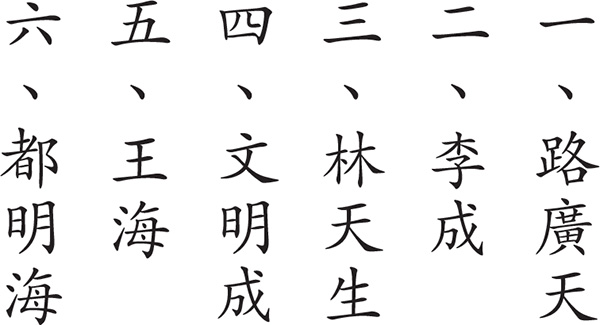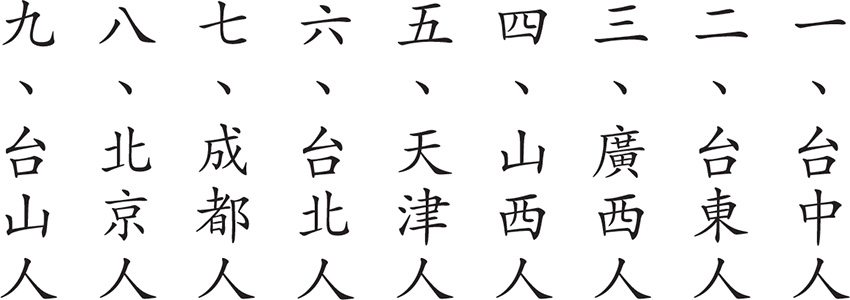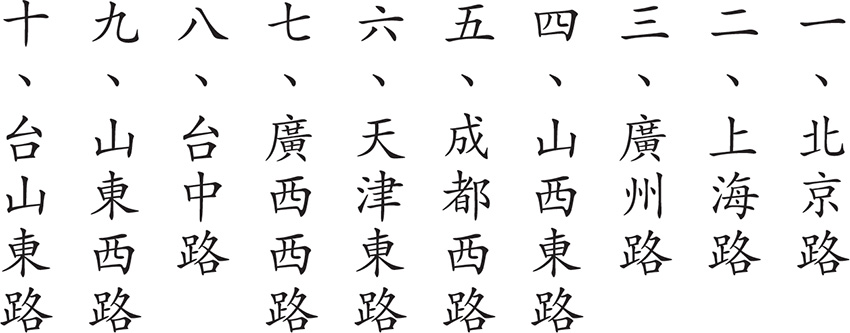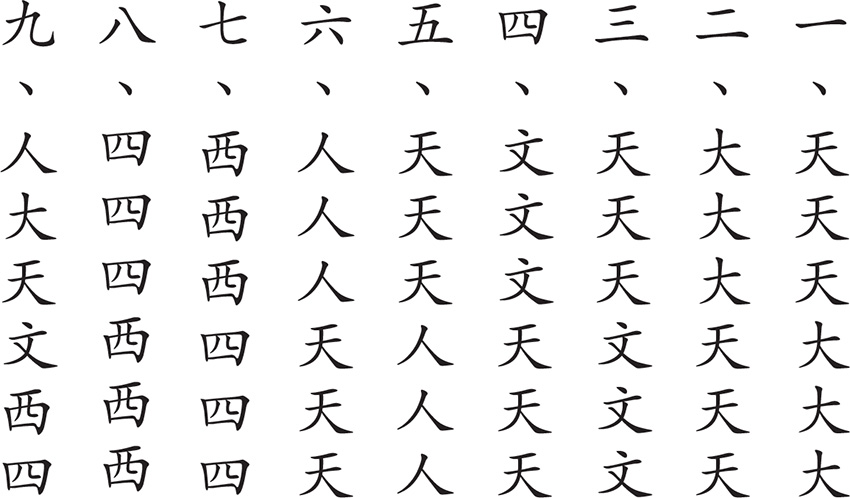PART 2
Personal Names, Place Names, People and Their Places of Origin, and Names of Roads
New Characters and Words 
Study the six characters below and the common words written with them, paying careful attention to each character’s pronunciation, meaning, and structure, as well as similar-looking characters. After you’ve studied a character, turn to the Practice Book volume and practice writing it on the practice sheet, making sure to follow the correct stroke order and direction as you pronounce it out loud and think of its meaning.
31 |
成 |
chéng |
become |
Radical is 戈 gē “spear” [BF]. 成 is itself a phonetic, e.g., in 城 chéng “city” and in 诚 ( 誠 ) chéng as in 诚实 ( 誠實 ) chéngshí “honest.” |
|||
32 |
都 |
dū |
large city, capital |
Radical is 邑 yì “city” [BF], which is written 阝 when occurring at the right-hand side of a character. This radical is referred to colloquially as 右耳旁 yòu’ĕrpáng “side made up of a right ear.” The component on the left side of 都 is 者 zhĕ, a nominalizing suffix that often means “one who does something.” A mnemonic for remembering this character is: “Cities” are where “those who do things” assemble. |
|||
都 |
Dū |
Du [SN] |
|
成都 |
Chéngdū |
Chengdu (capital of Sichuan Province) [PW] |
|
京都 |
Jīngdū |
Kyoto (major city in Japan) [PW] |
|
33 |
天 |
tiān |
sky, heaven |
Radical is 大 dà “big” (13). No matter how “big” people are (大), there is always something above them (the stroke on top: 一), which is the sky or heaven. 天 can serve as a phonetic in other characters, e.g., 添 tiān “add” and 舔 tiăn “lick.” Contrast 天 with 大 dà (13), 文 wén (21), and 人 rén (30). |
|||
34 |
津 |
jīn |
ford; (abbreviation for Tianjin) |
Radical is 水 shuĭ “water.” Notice that this radical is written 氵 and is referred to colloquially as 三点水 (三點水) sāndiăn shuĭ “three drops of water” when it occurs at the left-hand side of a character. |
|||
天津 |
Tiānjīn |
Tianjin (major port in north China) [PW] |
|
35 |
西 |
xī |
west |
西 is itself a radical. It can also serve as a phonetic, e.g., 牺 (犧) xī as in 牺牲 (犧牲) xīshēng “sacrifice.” The top stroke of this character represents a bird and the rest of the character represents the bird’s nest. When the sun sets in the west, it’s time for the birds to return to their nests, hence this character indicates “west.” Contrast 西 and 四 sì (4). |
|||
广西 ( 廣西 ) |
Guăngxī |
Guangxi (province) [PW] |
|
山西 |
Shānxī |
Shanxi (province) [PW] (lit. “west of the [Tàiháng] Mountains”) |
|
36 |
路 |
lù |
road |
Radical is 足 zú “foot” [BF], which at the left side of a character is referred to colloquially as 足字旁 zúzìpáng “side made up of the character 足.” Note that when this character is written as a radical, its last two strokes are different, with the last stroke curving up so as to make room for the component on the right. The other component of 路 is 各 gè “each.” Perhaps the following mnemonic will help you remember this character: Put “each” “foot” on the “road.” Note that 路 is often added to place words or personal names to create the names of roads. |
|||
路 |
Lù |
Lu (also Ro or Rho, a common Korean surname) [SN] |
|
路 |
lù |
road [N] |
|
上海路 |
Shànghăi Lù |
Shanghai Road |
|
成都西路 |
Chéngdū Xī Lù |
Chengdu West Road |
|
天津东路 ( 天津東路 ) |
Tiānjīn Dōng Lù |
Tianjin East Road |
|
Reading Exercises (Simplified Characters) 
Now practice reading the new characters and words for this lesson in context. Be sure to refer to the Notes at the end of this lesson, and make use of the accompanying audio disc to hear and practice correct pronunciation, phrasing, and intonation.
A. PERSONAL NAMES
Read out loud each of the following personal names.
一、路广天
二、李成
三、林天生
四、文明成
五、王海
六、都明海
B. PLACE NAMES
Read out loud each of the following place names.
一、成都
二、上海
三、广东
四、广西
五、天津
六、广州
七、山东
八、京都
九、东京
C. PEOPLE AND THEIR PLACES OF ORIGIN
Read out loud each of the following expressions, thinking of the meaning as you say it.
一、台中人
二、台东人
三、广西人
四、山西人
五、天津人
六、台北人
七、成都人
八、北京人
九、台山人
D. NAMES OF ROADS
Read out loud the names of each of these streets or roads in mainland China and Taiwan.
一、北京路
二、上海路
三、广州路
四、山西东路
五、成都西路
六、天津东路
七、广西西路
八、台中路
九、山东西路
十、台山东路
E. CHARACTER DIFFERENTIATION DRILLS
Distinguish carefully the following similar-looking characters, pronouncing each one out loud and thinking of its meaning.
一、天 天 天 大 大 大
二、大 大 大 天 天 天
三、天 天 天 文 文 文
四、文 文 文 天 天 天
五、天 天 天 人 人 人
六、人 人 人 天 天 天
七、西 西 西 四 四 四
八、四 四 四 西 西 西
九、人 大 天 文 西 四
Reading Exercises (Traditional Characters) 
A. PERSONAL NAMES
Read out loud each of the following personal names.

B. PLACE NAMES
Read out loud each of the following place names.

C. PEOPLE AND THEIR PLACES OF ORIGIN
Read out loud each of the following expressions, thinking of the meaning as you say it.

D. NAMES OF ROADS
Read out loud the names of each of these streets or roads in mainland China and Taiwan.

E. CHARACTER DIFFERENTIATION DRILLS
Read out loud the names of each of these streets or roads in mainland China and Taiwan.

Notes
D1. As in the West, Chinese roads may be named after famous cities, provinces, or people.